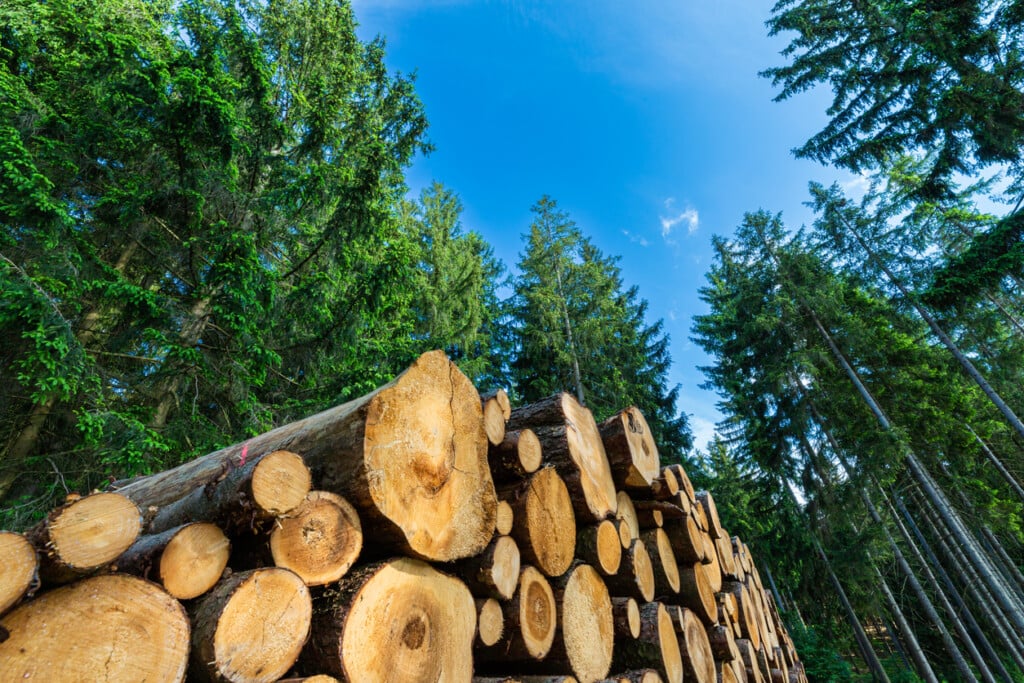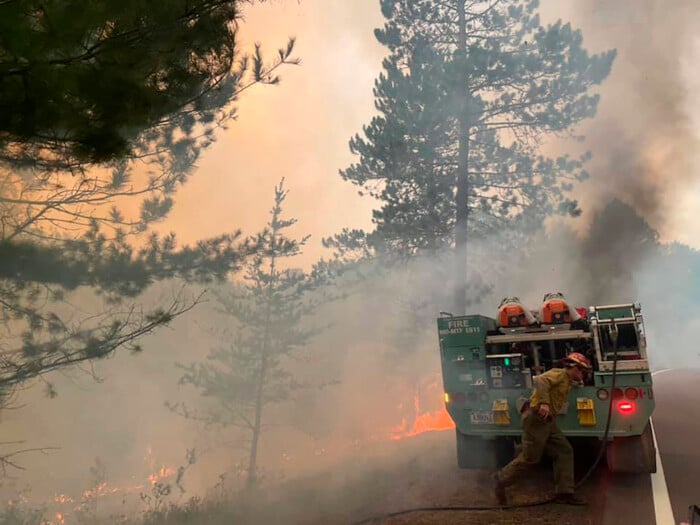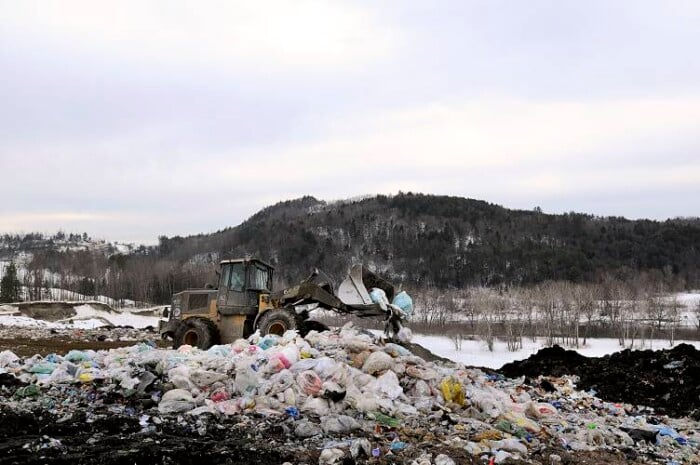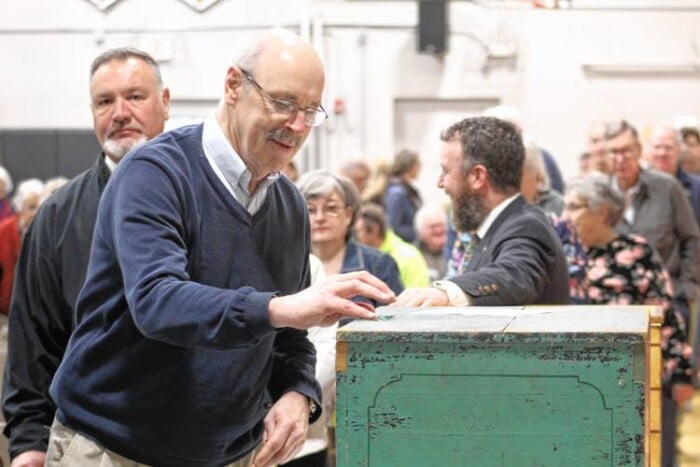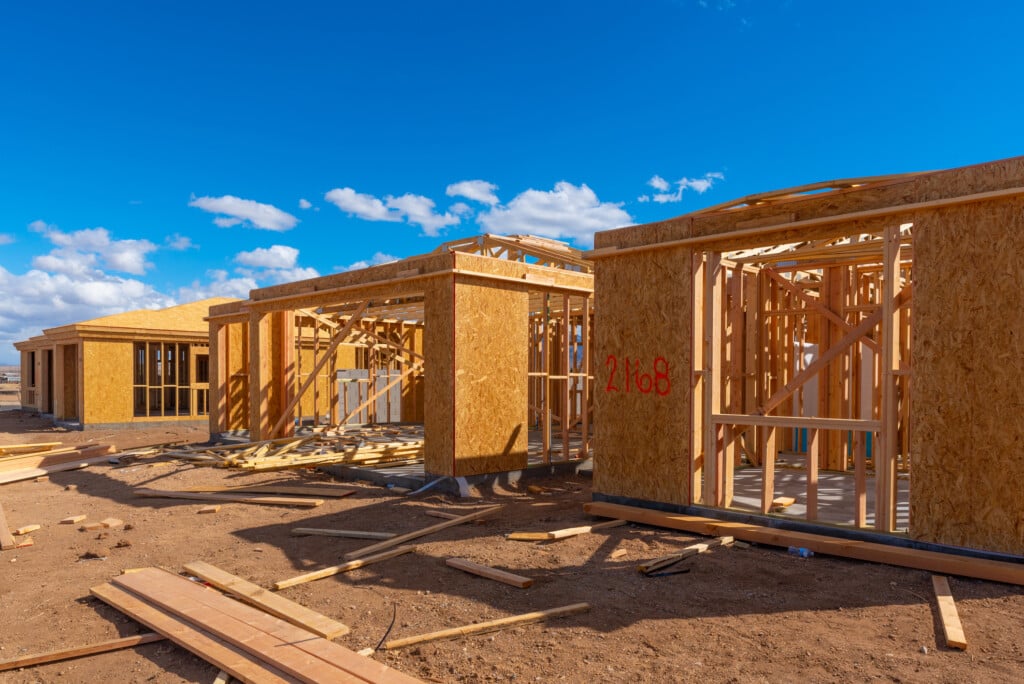Sunapee Elementary becomes latest Upper Valley school to heat with biomass
New biomass burner brings alternative, wood-burning option that saves money and doesn't rely on fossil fuels

Lucas Perry, a truck driver for Froling Energy, unloads a delivery of wood chips, which power Sunapee
Elementary School’s biomass heating system located next to the Sherburne Gym in Sunapee, NH, on
Thursday, Feb. 1, 2024. Ten tons of the hardwood chips, which run about $150 per ton, are delivered to the
school every two weeks. (Photo by Valley News / Report For America – Alex Driehaus)
A new heating system at Sunapee Elementary School is the “Corvette” of wood-burning operations, said Mathew Bouranis, the school district’s facilities director.
But a “Prius” may be a more apt comparison.
The burner rarely needs to fall back on fossil fuels and is less-expensive as compared to its oil- or propane-guzzling alternatives.
The school installed its wood-chip burner, known as a “biomass” plant — a term used for energy created from organic material — earlier this winter. The system runs hot water in coiled piping through classrooms across all of its buildings.
Older biomass plants light like an at-home wood stove. “Throw a pile of cardboard in there, and you’ve got it going,” Bouranis said. But this higher-tech model has its own built-in ignition, sparking wood chips into a burn “like a hairdryer,” he added.
Biomass isn’t new to schools in the Upper Valley. Considered to be a “cleaner” energy source than fossil fuels, classrooms in Hanover and Lebanon have kept toasty that way for over a decade.
In Vermont, one in three students attend a school heated by wood, according to the state’s Agency of Natural Resources.
It matters how students stay warm. Schools account for roughly 13% of energy consumption by U.S. commercial buildings, stated a report from the country’s Department of Energy.
More than half of that energy goes toward heating and cooling, the Rocky Mountain Institute, an environmental research group, has found.
Wood chips, sourced from the byproduct of several logging companies around New Hampshire, are periodically delivered to the Sunapee biomass plant by Froling Energy, the Keene, N.H.-based company that manufactured the school’s $810,000 biomass burner.
The School District supplemented the installation cost with a $250,000 grant from the state’s Department of Energy.
A fixed-price, yearly contract has Sunapee locked into paying $150 per ton of wood chips, which a vacuum-like tube loads into a 20-foot-tall fuel silo.
Froling procures its fuel through a “chip broker,” Bouranis said, delivering about 10 tons of wood chips a few times a week.
The financial benefit is notable. Wood chips cost less than the No. 2 fossil fuel oil the school was burning before, and the biomass plant generates “renewable energy credits,” or RECs, from the state, which gives the school about 30% back for what they spend on heating.
“We could potentially see what we put into the wood chips come back to us at the end of the season,” Bouranis said.
Biomass releases roughly the same amount of carbon dioxide as fossil fuels, but in theory emissions are balanced out by the carbon dioxide sequestered by the trees grown as fuel. As such, greenhouse gases released from biomass aren’t credited in Vermont or New Hampshire’s emissions calculations.
But clean energy advocates have long questioned the extent to which biomass should really be considered renewable.
Wood fuel has kept fierce debate on simmer in Burlington for years as Vermont’s largest city considers whether its wood-burning McNeil Energy Generator is renewable.
Calls to leave behind the No. 6 fuel oil that heats Dartmouth College’s campus spurred the school to consider building a biomass plant, but the idea fell apart in 2019 when a group of alumni involved in climate and energy voiced opposition.
A power source that requires deforestation isn’t very renewable in practice, they argued. The tree growth required to truly cancel out biomass emissions can take at least decades, lest the energy source become “nonrenewable,” according to the University of Pennsylvania’s Kleinman Center for Energy Policy.
Most schools heating with biomass have an alternative system — typically powered by fossil fuels — as a backup. Various complications with the biomass burner in Sunapee have resulted in $11,000 worth of emergency propane use — almost equivalent to the amount they were poised to save, Bouranis said.
Still, biomass remains an essential energy alternative in New Hampshire, which has some of the highest electric rates in the country. Electrical-powered heat pumps are a less-attractive renewable energy option, said Tony Daigle, director of facilities for the Dresden School District, which includes schools in Norwich and Hanover.
Compared to heat from fossil fuels, Daigle estimated that biomass burners at Hanover High School and Frances C. Richmond Middle School save the district about a third of what it would have spent on fossil fuels for heating.
Events overseas, such as Russia’s invasion of Ukraine, have made the cost of fossil fuels increasingly erratic. In the eight years that Daigle has been head of facilities at Hanover, the price of wood fuel has changed only negligibly, and he’s witnessed the cost of oil increase by over a dollar a gallon.
“That’s the nature of the world-wide wars,” Daigle said.
Wood from timber harvested in New Hampshire, he added, has proved more dependable.
Frances Mize is a Report for America corps member. She can be reached at fmize@vnews.com or 603-727-3242.
This article is being shared by partners in The Granite State News Collaborative. For more information, visit collaborativenh.org.
